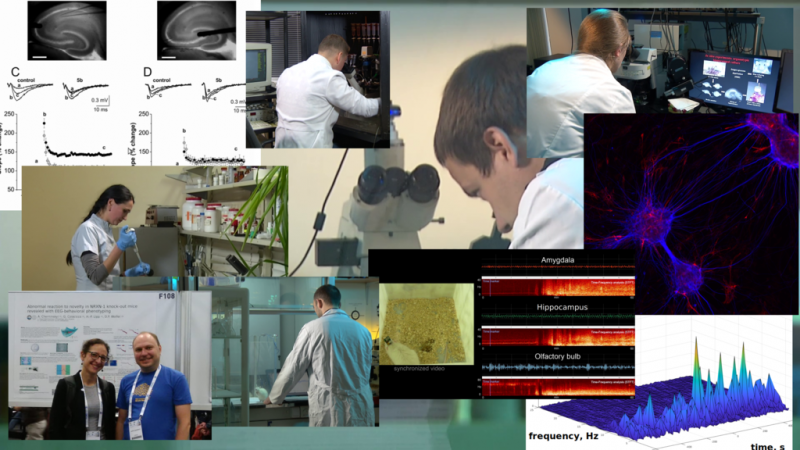Department of Cellular Membranology
Contents |
Our research
Our Department research is focused on the role of membrane proteins, mainly ion channels and metabotropic receptors, in the functioning of single neurons, neural networks, and the whole organs. The current research topics of the Department are:
- biophysical and pharmacological properties of ion channels and receptors of cellular membranes (plasmalemma and nuclear envelope);
- molecular mechanisms of epilepsy and epileptogenesis and pharmacological agents with antiseizure properties;
- role of membrane receptors and ion channels in synaptic plasticity, learning, integral activity of nervous system and behavior;
- peripheral and central mechanisms of pain and possible ways of its correction;
- using of stem cells for the treatment of neurological disorders (Alzheimer’s, Parkinson’s disease, epilepsy, and ischemic stroke) and
traumatic injuries of the spinal cord.
Methods
Highly qualified Departments’ staff has strong expertise in virtually all electrophysiological techniques, various disease models and cell/tissue cultural techniques allowing studying physiological functions and some pathologies from molecular to system levels including:
- pharmacological patch-clamp studies of different ion channels in acutely isolated cells (pyramidal neurons from hippocampus, cortex, and hypothalamus; Purkinje and granule neurons from cerebellum; spinal dorsal horn neurons; primary sensory neurons; glial cells), cultured cells (the same as above; cancer cell lines) and heterologous expression systems (HEK293, CHO, and PC-12 lines);
- registration of electrical activity of single neurons, local field potentials, EEG in freely behaving animals;
- isolation and cultivation of stem cells and tissue engineering;
- electrophysiological studies of primary nociception ex vivo and in vivo;
- seizure-like activity in acute isolated and cultured brain slices in various models of epilepsy as well as intracranial EEG in various in vivo models of epilepsy;
- a wide range of behavioral tests (open field, different mazes, Morris water maze, etc) that allow us to study general locomotor activity, anxiety and depression-like behavior, learning and memory, social behavior, etc.
Collage (clockwise): The effect of ASIC1a inhibition on hippocampal LTP (Buta A et. al, J. Med. Chem. 2015); patch-clamp technique (V. Kulyk); confocal microscopy of neural stem cell culture and neurospheres - astrocytes are red, neurons blue (O. Rybachuk); brain structures' LFPs in freely moving rat and it's spectrogram (R. Bohovyk); meeting colleagues at FENS Forum (A. Cherninskyi and E. Knapska); making artificial cerebrospinal fluid (O. Iegorova); central — specimens' microscopy (M. Fedoriuk).
Members
Research staff
Prof. Oleg Krishtal - the head of department, PhD, DSc, Professor, Member of Academia Europaea, Full Member of the National Academy of Sciences of Ukraine
Dr. Oleksandr Maximyuk - leading researcher, PhD
Dr. Maksim Storozhuk - leading researcher, PhD, Dsc
Dr. Dmytro Isaev - leading researcher, PhD
Dr. Ihor Chizhmakov - senior researcher, PhD
Dr. Andrii Cherninskyi - senior researcher, PhD
Dr. Anna Kotliarova - senior researcher, PhD
Dr. Alina Savotchenko - researcher, PhD
Dr. Olena Iegorova - researcher, MD, PhD
Dr. Viacheslav Kulyk - researcher, PhD
Dr. Oksana Rybachuk - researcher, PhD
Dr. Dariia Dryn - researcher, PhD
Dr. Mariia Melnyk - researcher, PhD
Tetiana Volkova - researcher
Andrii Buta - researcher
Liudmila Nikolaienko - junior researcher
Olha Zapukhliak - junior researcher
Volodymyr Khmyz - junior researcher
Yurii Tkachenko - junior researcher
Artur Romanov - junior researcher
Oleksii Lunko - junior researcher
Olesia Lunko - junior researcher
Ruslan Bohovyk - junior researcher
Mykhailo Fedoriuk - junior researcher
Olena Kotyk - junior researcher
Technical stuff and secretary
Artem Venhreniuk
PhD students
Sofiia Demchenko
Mariia Stefanenko
Marharyta Semenikhina
Oksana Nikolaienko
Pavlo Novikov
Iuliia Nesterenko
Technical staff and secretary
- Liudmila Smolina
Publications
- Tesoriero, C; Codita, A; Zhang, MD; Cherninsky, A; Karlsson, H; Grassi-Zucconi, G; Bertini, G; Harkany, T; Ljungberg, K; Liljestrom, P; Hokfelt, TGM; Bentivoglio, M; Kristensson, K H1N1 influenza virus induces narcolepsy-like sleep disruption and targets sleep-wake regulatory neurons in mice Proceedings Of The National Academy Of Sciences Of The United States Of America, 113 (3), 2016, E368-E377 (DOI: 10.1073/pnas.1521463112, IФ 9,75)
- McGarvey L.P., Butler C.A., Stokesberry S., Polley L., McQuaid S., Abdullah H., Ashraf S., McGahon M.K., Curtis T.M., Arron J., Choy D., Warke T.J., Zholos, A Bradding P., Ennis M., Costello R., Heaney L.G.Increased expression of bronchial epithelial transient receptor 1 potential vanilloid 1 channels in severe asthma Journal of Allergy and Clinical Immunology 133 (3), 2014, 704-712 (DOI: 10.1016/j.jaci.2013.09.016, IФ 12, 49)
- Krishtal O Receptor for protons: First observations on Acid Sensing Ion Channels NEUROPHARMACOLOGY, 94, 2015, 4-8 (DOI: 10.1016/j.neuropharm.2014.12.014, IФ 5,10)
- Ievglevskyi, D Isaev, O Netsyk, A Romanov, M Fedoriuk, O Maximyuk, E Isaeva, N Akaike, O Krishtal Acid-sensing ion channels regulate spontaneous inhibitory activity in the hippocampus: possible implications for epilepsy The Royal Society Phil. Trans. R. Soc. B, 2016, 371(1700). pii: 20150431 (DOI: 10.1098/rstb.2015.0431, IФ 7,06)
- Andriy Buta, Oleksandr Maximyuk, Dmytro Kovalskyy, Volodymyr Sukach, Mykhailo Vovk, Dmytro Isaev, Oleksandr Ievglevskyi, Elena Isaeva, Alina Savotchenko, Oleg Krishtal Novel potent orthosteric antagonist of ASIC1a prevents NMDAR-dependent LTP induction J Med Chem. 2015 Jun 11;58(11):4449-61. (DOI: 10.1021/jm5017329, IФ 6, 26)

